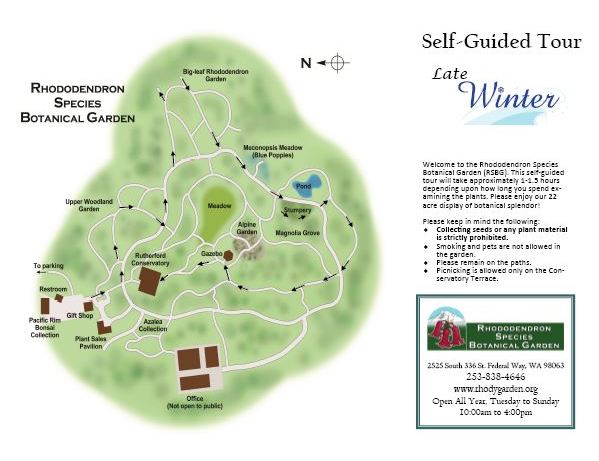#1 Rhododendron strigillosum welcomes you to the gar-den as you enter to the courtyard. This early flowering species puts on a spectacular display every year. It has distinctive bristles on the midrib, petiole, and foliage. R. strigillosum is native to Sichuan and NE Yunnan, China.
Turn left on the main road and continue to the path on the left. This area is called the Upper Woodland Garden which features many species with thickly indumented leaf undersurfaces. On your right, you will find #2 Winter Hazel (Corylopsis sp.) with yellow flowers that look like small lanterns. This particular plant was collected wild in China in 1995. Further along the path on your left is #3 Rhododendron principis. This is a very attractive species with thick and spongy white indumentum on the underside of the leaves. It is found only in E. Tibet where it is common in a wide variety of habitats.
Keep going downhill and stay on the right path as it veers to the right. Go across the main road to visit #4 Rhododendron praevernum. This quite showy and very hardy species is native to W. Hubei and E. Sichuan, China.
Go back to the main road and go down the hill. Right after you pass the bamboo on your right, you will see #5 Rhododendron oreodoxa var. fargesii. This is an easily grown and free flowering species with very frost hardy flower buds. That is why they bloom reliably every year despite the early season bloom. It is native to woodlands in Sichuan, Gansu, and Hubei in China.
Now take the next left turn to visit the Big-Leaf Garden. Most of the big-leafed rhododendrons eventually become very large trees in their native temperate rainforests in the Sino-Himalaya. Many of these rhododendrons bloom fairly early in season including R. rothschildii and R. praestans. Keep going straight and enjoy the clear pink flowers of #6 Camellia ‘Water Lily’.
Follow the sign to visit the newly renovated Big-leaf forest. Here you will find particularly hardy big-leaf species for our Pacific Northwest climate such as R. kesangiae* and R. hodgsonii*. In 10 years, most of the rhododendrons planted in this area will be 15 to 20 feet tall.
Follow the sign to walk back toward the main road. On your right you will notice a large planting of clumping evergreen perennial plants in full flower. This is a lily relative from China known as #7 Ypsilandra thibetica* and the white flowers are very fragrant. This easily grown woodland wildflower was introduced into cultivation by the RSBG. Across from Ypsilandra is #8 Camellia grijsii from SE China. The population of this camellia in the native habitat of China is declining due to deforestation.
Now, go back to the main road and take a left. Walk past the black bamboo on your left. Just past the bamboo is the Meconopsis meadow planted with hundreds of Himalayan Blue Poppies*. Check out the new growth of Cardiocrinum giganteum* (#9) which looks similar to a shiny giant green hosta. This is the Himalayan Giant Lily which can grow to 12 feet tall with masses of six inch long fragrant flowers in June. The clusters of emerging fuzzy leaves are the Blue Poppies. Make sure you come back to see them blooming in late April and May, it’s spectacular. The bright red flowers next to the Meconopsis Meadow is #10 Rhododendron barbatum with very attractive smooth peeling bark. This species is native to the high mountain forests of the Himalayas.
Keep going along the main path until you see the Hardy Fern Foundation’s Stumpery (#11) on your right. A stumpery is a Victorian period garden design that romanticizes nature. The design uses tree roots, placed on their sides or upside down. The tree roots are exposed creating a “Wild Scene” and then planted with thousands of ferns and other woodland plants. As you enter the stumpery, you will note a grove of red-flowering Rhododendron strigillosum (#12) on your right. Explore the stumpery to find the rare Chinese groundcover #13 Chrysosplenium macrophyllum in flower. You will also find #14 Rhododendron mallotum* with bright red flowers and a dense wooly cinnamon-brown indumentum on the undersides of the leaves. This species is considered among the finest of all rhododendrons in terms of its beautiful foliage.
From the stumpery, take the path to the pond garden (follow the sign). #15 Rhododendron lanigerum is putting on a spectacular show this year. It is a rare species from Tibet and NE India. Take a right turn to visit #16 Rhododendron ririei. The bell-shaped flowers are purplish in color with dark nectar pouches and the lower surface of the leaves is covered with a thin plastered indumentum. It is native to a limited area of Sichuan, China. Further along the path on your right is #17 Rhododendorn faucium from S. Tibet. This species has beautiful peeling bark as the plant matures.
Proceed around the curve and keep going straight. Follow the signs across the road until you reach #18 Rhododendron leucaspis with its flat white flowers and chocolate anthers. The leaves are densely covered with soft hairs. This plant is native to SE Tibet. Right after that, you will see #19 Rhododendron lutescens on your right. This lovely species with pale yellow flowers also has attractive reddish new growth.
Take the next right and walk toward the gazebo which is surrounded by #20 Rhododendron degronianum ssp. yakushimanum*. Come back in early May to see the impressive floral display of this species. Follow the signs for the self-guided tour which will take you past #21 Stewartia pseudocamellia*, a summer-flowering tree with beautiful bark. This camellia relative also has colorful fall foliage.
Continue straight ahead to the Rutherford Conservatory. (A separate self-guided handout is available to tour the Rutherford Conservatory)
From here, you can walk back to the Visitor Center where you started. Many of the plants you viewed today are available in the RSBG nursery area but are quite rare in regular retail nurseries. We hope you enjoyed the self-guided tour today. Please come back and visit the garden soon.
* For sale at the RSBG Nursery

